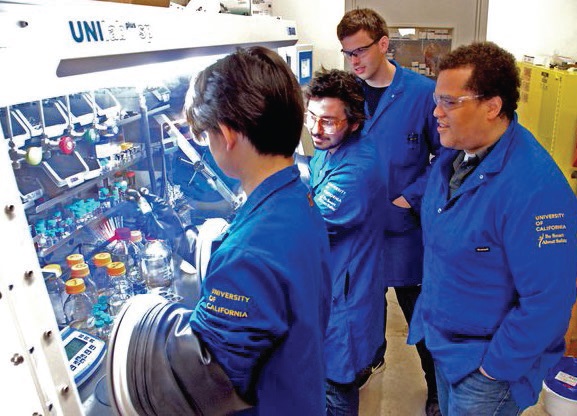New approach to functionalize aromatic hydrocarbons
Dr. Neil Canter, Contributing Editor | TLT Tech Beat October 2017
The process is conducted under mild reaction conditions.
KEY CONCEPTS
•
Insertion of an aromatic molecule into the C-H bond of a hydrocarbon is a new method for functionalizing aromatic hydrocarbons.
•
The proposed mechanism for this process involves the formation of a phenyl carbocation.
•
This process may lead to new approaches for synthesizing alkylated aromatic molecules that may be used as precursors to commonly used lubricant additives such as sulfonates.
EFFORTS TO MAKE DERIVATIVES OF SIMPLE HYDROCARBONS such as methane have proven to be difficult because of the stability of the carbon-hydrogen bond. Current approaches such as the use of the Fischer-Tropsch reaction tend to be energy intensive and expensive.
In a previous TLT article, researchers converted simple hydrocarbons into alcohols at much lower temperatures using a process known as C-H activation (
1). The reaction occurs between a hydrocarbon and an organometallic compound. A metal alkyl intermediate is formed in the transition to the alcohol. Propane is more reactive than ethane, which is more reactive than methane in this reaction.
Carbocations are species where the carbon atom has a positive charge because it is attached to three other atoms and only has six electrons surrounding it. Due to not possessing eight electrons (referred to as not satisfying the “octet rule”), carbocations are generally unstable and very reactive.
One carbocation that has not been identified but is suspected to exist is derived from benzene and other aromatic compounds and is known as a phenyl carbocation. Hosea Nelson, assistant professor in the department of chemistry & biochemistry at the University of California, Los Angeles in Los Angeles, says, “We intended to work with this type of carbocation in a biomimetic, natural product synthesis using a weakly coordinating anion such as monocarborane anion. A high energy barrier exists in preparing the phenyl carbocation, but once this species forms it will quickly react.”
When the researchers attempted to use this approach in a cationic cyclization, the reaction was conducted in an aromatic solvent. Nelson says, “Instead of achieving the desired cyclization, we found that the carbocation formed reacted with the solvent.”
This unexpected development led the researchers to further examine the potential for this reaction in functionalizing aromatic hydrocarbons.
CARBON-HYDROGEN INSERTION REACTION
Nelson and his colleagues determined that reaction of an aromatic molecule functionalized with a fluorine atom and a beta-trimethylsilyl group in an ortho orientation, with a hydrocarbon led to the insertion of the aromatic into the hydrocarbon C-H bond. The process is catalyzed by a trimethylsilyl carborane species. Nelson says, “We evaluated this process with a wide range of hydrocarbon substrates and found that most of the reactions will take place under mild conditions (temperatures between 30 C and 100 C and time frames that were typically less than 24 hours).”
Reactions were typically conducted in a glove box as shown in Figure 3.
 Figure 3. A new synthetic method for functionalizing aromatic molecules is conducted under mild reaction conditions in a glove box. (Figure courtesy of the University of California, Los Angeles.)
Figure 3. A new synthetic method for functionalizing aromatic molecules is conducted under mild reaction conditions in a glove box. (Figure courtesy of the University of California, Los Angeles.)
Nelson differentiates this process from the classic Friedel-Crafts reaction where a hydrocarbon is added to an aromatic molecule through use of an alkyl halide species. He says, “Our process does not display the same selectivity as the Friedel-Crafts reaction. Products formed through the phenyl carbocation intermediate contain a statistical product mixture but interestingly can lead to products not observed under classical Friedel-Crafts reactions.”
Nelson believes that a phenyl carbocation was formed because the trimethylsilyl group was very effective in protecting the carbocation and effective at abstracting the fluorine atom from the benzene ring. He says, “The presence of the trimethylsilyl group essentially lowered the energy barrier enabling the phenyl carbocation to form.”
At this point of the reaction, the aryl cation inserts into the hydrocarbon C-H bond at the position where the fluorine atom was prior to the start of the reaction. To complete the process, the trimethylsilyl group leaves and reforms the catalyst.
Further clues about the mechanism of the reaction were derived from the behavior of substituted fluorinated aromatic compounds. Nelson says, “We found that substitution of an n-butyl group adjacent to the trimethylsilyl group led to a faster reaction by an order of a magnitude. The butyl group acted to support the abstraction of the fluorine atom from the benzene ring and then for steric reasons, facilitated the removal of the trimethysilyl group.”
In working with more complex aromatic substrates containing other halogen atoms such as bromine, chlorine and iodine, the reaction showed selectivity in just removing the fluorine atom. The other halogen atoms were not involved in the reaction.
The researchers also were able to add methane onto an aromatic molecule through a direct reaction in the presence of the solvent, hexafluorobenzene. Nelson says, “The strong carbon-hydrogen bond dissociation energy in methane makes this molecule difficult to react. We were able to activate methane through using a less reactive solvent and did it under reaction conditions that did not involve the use of transition metal catalysts.”
The successful reaction of methane and other simple hydrocarbons may lead to new ways for converting these components in natural gas into more functionalized derivatives that can be used as base stocks or additives in lubricants.
Attempts were made to work with alkylated aromatics such as mesitylene (1,3,5-trimethylbenzene). Nelson says, “We did detect a reaction but produced complicated product mixtures that have been difficult to characterize.”
The importance of this last reaction process for the lubricant market is that aromatic sulfonates used as detergents, corrosion inhibitors, emulsifiers and extreme pressure additives are prepared from alkylated aromatic molecules. The work conducted by these researchers may lead to a new approach for developing novel alkylated aromatic molecules that may produce different types of sulfonates with interesting properties.
Additional information can be found in a recent article (
2) or by contacting Nelson at
hosea@chem.ucla.edu.
REFERENCES
1.
Canter, N. (2014), “Functionalizing hydrocarbons derived from natural gas,” TLT,
70 (6), pp. 18-19.
2.
Shao, B., Bagdasarian, A., Popov, S. and Nelson, H. (2017), “Arylation of hydrocarbons enabled by organosilicon reagents and weakly coordinating anions,”
Science,
355 (6332), pp. 1403-1407.
 Neil Canter heads his own consulting company, Chemical Solutions, in Willow Grove, Pa. Ideas for Tech Beat items can be sent to him at neilcanter@comcast.net
Neil Canter heads his own consulting company, Chemical Solutions, in Willow Grove, Pa. Ideas for Tech Beat items can be sent to him at neilcanter@comcast.net.